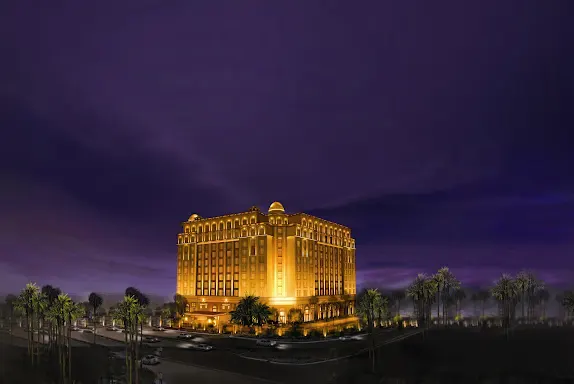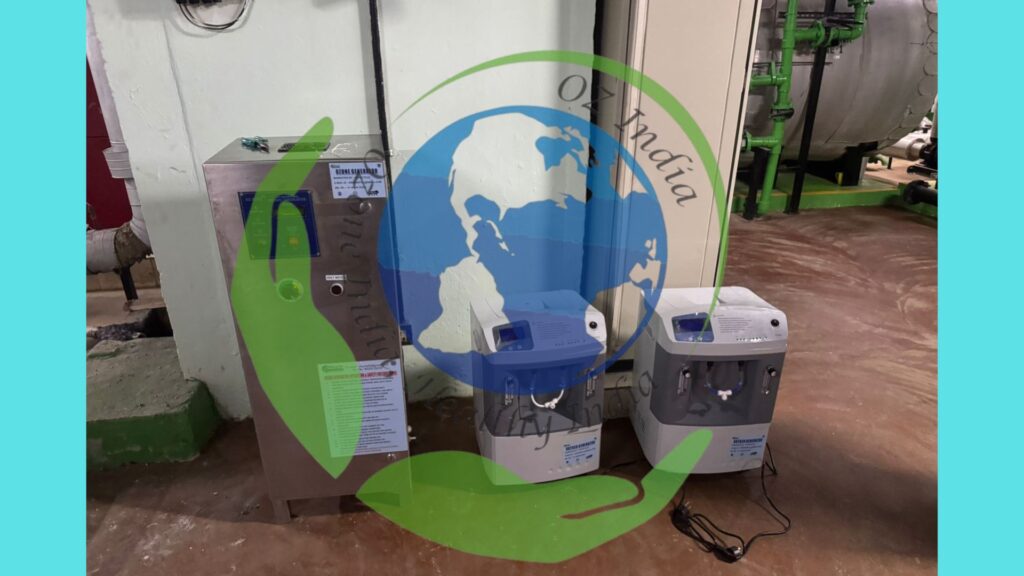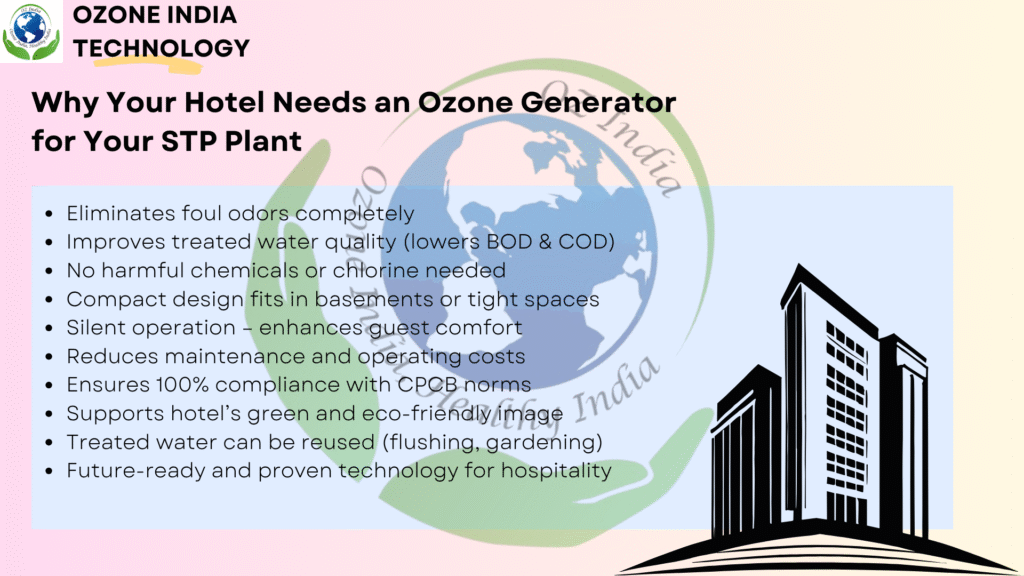Introduction: Sustainability Meets Hospitality
In the modern hospitality industry, guest satisfaction includes not only comfort and luxury but also hygiene, sustainability, and environmental responsibility. The Leela Palace Hotel, a premium hotel located in a busy city area, serves both business and leisure travellers. To meet high environmental standards and follow pollution control rules, the hotel faced a major challenge: how to carry out wastewater treatment with ozone generator in STP within limited space.
The only feasible location for setting up the sewage treatment plant (STP) was in the underground basement. This space constraint, along with strict environmental regulations and the need to ensure guest satisfaction, led the hotel to search for an innovative solution. After careful consideration, The Leela Palace Hotel decided to implement wastewater treatment with ozone generator in STP to achieve advanced purification.
This case study shows how wastewater treatment with ozone generator in STP helped the hotel upgrade its water management system, meet compliance standards, and support sustainable hospitality operations.
If you don’t wanna read the whole blog, you can watch the video –
The Challenge: Managing an STP in a Confined Basement Space
The Leela Palace Hotel had to install its Wastewater Treatment with Ozone Generator in STP (Sewage Treatment Plant ) in the underground basement due to a lack of space elsewhere. However, this setup created several operational and environmental problems:
1. Limited Physical Space
- The basement had very little room.
- This made it impossible to install large machines or tanks that are usually required in traditional sewage treatment systems. The hotel needed a compact solution that could fit in a tight area without compromising performance.
2. Odour Complaints
- Even though the hotel used biological treatment methods (like MBBR), the treated water and sludge still produced unpleasant smells.
- These foul odours travelled from the basement into nearby service areas used by staff or located near guest facilities. This negatively affected the guest experience and hotel reputation.
3. High BOD and COD Levels
- BOD (Biochemical Oxygen Demand) and COD (Chemical Oxygen Demand) are key indicators of how clean the treated water is.
- At times, the treated water had high BOD/COD values, meaning it wasn’t fully clean or safe to discharge or reuse. This made the hotel non-compliant with local pollution control standards, which could lead to legal or environmental issues.
4. Guest Experience at Risk
- Apart from odour, there were occasional noises or chemical smells from the basement STP.
- These disturbances could reach guest rooms or corridors nearby, leading to discomfort and complaints. Since hospitality depends heavily on guest satisfaction, any negative impact on comfort is a serious issue.
5. Maintenance Strain
- The traditional treatment system used chlorine for disinfection.
- Chlorine requires regular monitoring, manual handling, and storage of chemicals. This increases the cost of operation and also creates safety risks for the staff.

The Solution: Installing an Ozone Generator in the STP – Explained
To solve the problems related to odour, limited space, poor water quality, and maintenance issues, the Leela Palace Hotel teamed up with OIT (Ozone Innovation Technology). They decided to upgrade the existing sewage treatment system by adding ozone-based tertiary treatment.
This solution involved adding ozone technology to the final stage of treatment (tertiary stage), which made the treated water much cleaner, odour-free, and safe to reuse.
Key Parts of the Solution
1. Oxygen-Fed Ozone Generator
- The system uses pure oxygen (not air) to generate high-concentration ozone gas.
- It works using PSA (Pressure Swing Adsorption) technology, which removes nitrogen and moisture from air to produce concentrated oxygen. This makes the ozone more powerful and effective in treating wastewater.
2. Ozone Diffusion System
- Ozone gas is pushed into the treated water using micro-bubble diffusers inside special contact tanks.
- These micro-bubbles help the ozone mix evenly in water. This ensures that all harmful bacteria and organic matter are removed.
3. Automated Control System
- The setup includes smart sensors to monitor:
- Ozone levels
- Flow rates
- System pressure
- It can adjust automatically if something goes wrong. This reduces the need for manual monitoring and increases system reliability.
4. Safety Infrastructure
- Since ozone is a strong gas, safety is very important, especially in a basement.
- The system includes:
- Leak detection sensors
- Automatic alarms
- Ventilation systems to remove extra ozone
- These features ensure safe operation for staff and guests.
5. Silent Operation
- The ozone generator works very quietly.
- This is ideal for hotels because it does not disturb guests or create noise pollution.
- It blends perfectly with the peaceful environment expected in hospitality.

Implementation Process: Efficient, Customised, and Safe
The installation of the ozone generator system at The Leela Palace Hotel was completed in just three weeks. The process included careful planning, tailored equipment design, and attention to safety—all while ensuring there was no disruption to hotel operations.
The first step was a detailed site analysis conducted by OIT’s engineering team. They studied the layout of the basement to understand spatial constraints and evaluated existing ventilation and humidity levels. The team also analysed wastewater flow rates and volume to determine the right capacity for Wastewater Treatment with Ozone Generator in STP. This initial assessment was critical to ensure the system would fit efficiently in the limited space without causing safety risks.
Next came the system design phase, where a custom ozone treatment setup was created specifically for The Leela Palace Hotel’s requirements. Engineers designed a compact, high-efficiency ozone generator, along with a matching diffusion system, based on the existing STP flow rate and expected wastewater load. The design also ensured silent operation and compatibility with the current MBBR-based tertiary treatment stage.
Following the design, the required equipment was fabricated and delivered. The fabrication process focused on reducing equipment size and operational noise to suit the quiet hotel environment. The components were designed to be modular and easy to assemble in the constrained basement space. Once manufactured, the equipment was delivered on schedule, ready for installation.
During the installation and integration stage, the Wastewater Treatment with Ozone Generator in STP was smoothly connected to the hotel’s existing sewage treatment infrastructure. Importantly, there was no need for civil modifications or structural changes in the basement. The integration was done with minimal interruption to hotel services, making the transition seamless and efficient.
The final step involved training and testing. Hotel maintenance staff were trained on how to operate the ozone system safely, including how to respond to alerts or faults. Comprehensive system testing followed, ensuring the ozone generator worked reliably under full load conditions. This phase also included verifying safety mechanisms like leak detection, ventilation, and ozone concentration controls. Due to the underground setting, special attention was given to ensuring safety. The basement environment required reliable ventilation, humidity management, and gas detection systems to prevent ozone buildup and maintain healthy air quality. These safety features were integrated into the system to provide long-term operational confidence.
Measurable Results: Data-Driven Improvements
Within just 30 days of installing the Wastewater Treatment with Ozone Generator in STP , The Leela Palace Hotel observed significant improvements in both the performance of its sewage treatment plant (STP) and overall guest satisfaction. Before the installation, the treated water often had high levels of Chemical Oxygen Demand (COD), regularly exceeding 200 mg/L, and Biological Oxygen Demand (BOD) ranging between 30–40 mg/L. These levels indicated the presence of organic pollutants and were a concern for compliance and reuse. Additionally, foul odours were commonly reported in the treated water, and occasional complaints arose due to noise and chemical smells near the basement service areas. Operational costs were also high, largely due to manual monitoring and chemical handling involved in traditional methods like chlorination.
After integrating the ozone generator, there was a dramatic improvement in treatment quality. COD levels dropped to below 50 mg/L, and BOD levels fell under 10 mg/L, making the water much safer and clearer. The odour issue was completely resolved, creating a more pleasant environment for both guests and staff. The Wastewater Treatment with Ozone Generator in STP also operated silently, eliminating noise complaints. Importantly, operational costs were reduced by 20% due to lower chemical usage and automated monitoring. The treated water, now free from harmful pathogens and unpleasant smells, became safe for non-potable reuse, such as flushing toilets and maintaining landscaped areas, aligning perfectly with the hotel’s sustainability goals.
Benefits of The Leela Palace Hotel
1. ROI in Under 2 Years
The Wastewater Treatment with Ozone Generator in STP helped The Leela Palace Hotel save money through lower maintenance costs and by eliminating the need for chemicals like chlorine. Since the system uses automated controls and energy-efficient technology, it requires minimal manual effort. These savings added up quickly, allowing the hotel to recover its investment in just 22 months. This quick return on investment made the project financially beneficial, not just environmentally friendly.
2. Eco-Friendly Image
By choosing Ozone India technology—a chemical-free, green solution—The Leela Palace Hotel strengthened its reputation as a sustainable and responsible business. This shift was especially appreciated by eco-conscious guests, including international travellers who value hotels that actively care for the environment. The upgrade gave the hotel a competitive edge and improved its brand image as a modern, environmentally aware establishment.
3. 100% Compliance with Pollution Control Norms
After installing the Wastewater Treatment with Ozone Generator in STP, the treated water consistently met all discharge standards set by the Central Pollution Control Board (CPCB). This helped the hotel avoid any regulatory issues, fines, or penalties. Being fully compliant also meant that the hotel was contributing positively to environmental protection by discharging cleaner water into the ecosystem.

4. No Chemical Handling for Staff
Previously, hotel staff had to store and manually apply disinfectants like chlorine, which posed safety risks such as chemical exposure, accidental spills, and the need for protective equipment. With the Wastewater Treatment with Ozone Generator in STP, disinfection happens automatically and without harmful chemicals. This significantly improved safety and reduced the workload for staff, creating a safer and more efficient working environment.
5. Treated Water Reuse for Gardening and Flushing
One of the major practical benefits was that the treated water became safe for non-drinking uses, such as watering the garden and flushing toilets. This helped the hotel save a large amount of freshwater every day, reducing both environmental impact and water bills. Reusing treated water also supported the hotel’s goal of resource conservation and sustainable operation.
Conclusion: A Model for Smart, Sustainable STP Solutions
The Leela Palace Hotel’s experience proves that modern Wastewater Treatment with Ozone Generator in STP is not just possible, but highly effective, even in space-constrained environments like basement setups. The compact design, chemical-free operation, and low maintenance of the ozone generator made it an ideal solution for improving water quality, eliminating odour, and achieving complete compliance with environmental regulations. Within a short time, the hotel witnessed better guest satisfaction, reduced operational costs, and a strong return on investment—all while enhancing its reputation as a sustainable, forward-thinking hospitality brand.
This successful transformation acts as a powerful example for other hotels, especially those in urban areas where space is limited and environmental expectations are growing. It demonstrates that upgrading to ozone technology is not only feasible but also strategically smart for the long term. Other hospitality businesses struggling with odour issues, rising treatment costs, or regulatory compliance can learn from The Leela Palace Hotel’s results and gain confidence in making similar improvements. As sustainability becomes a key decision factor for travellers, adopting such technologies can offer a competitive edge while supporting broader environmental goals.
If your facility is facing similar challenges with Wastewater Treatment with Ozone Generator in STP —whether due to limited space, odour complaints, or rising costs—OIT’s ozone-based solutions can provide a reliable and future-ready answer. The Leela Palace Hotel has shown the way, and now others can follow.

